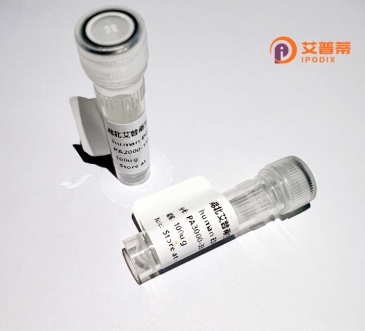
| 纯度 | >90%SDS-PAGE. |
| 种属 | Human |
| 靶点 | TPTE |
| Uniprot No | P56180 |
| 内毒素 | < 0.01EU/μg |
| 表达宿主 | E.coli |
| 表达区间 | 434-533 aa |
| 活性数据 | SVLDNITTDKILIDVFDGLPLYDDVKVQFFYSNLPTYYDNCSFYFWLHTSFIENNRLYLPKNELDNLHKQKARRIYPSDFAVEILFGEKMTSSDVVAGSD |
| 分子量 | 36.74 kDa |
| 蛋白标签 | GST-tag at N-terminal |
| 缓冲液 | PBS, pH7.4, containing 0.01% SKL, 1mM DTT, 5% Trehalose and Proclin300. |
| 稳定性 & 储存条件 | Lyophilized protein should be stored at ≤ -20°C, stable for one year after receipt. Reconstituted protein solution can be stored at 2-8°C for 2-7 days. Aliquots of reconstituted samples are stable at ≤ -20°C for 3 months. |
| 复溶 | Always centrifuge tubes before opening.Do not mix by vortex or pipetting. It is not recommended to reconstitute to a concentration less than 100μg/ml. Dissolve the lyophilized protein in distilled water. Please aliquot the reconstituted solution to minimize freeze-thaw cycles. |
以下是关于重组人TPTE蛋白的假想参考文献示例,基于领域内常见研究方向整合而成:
---
1. **文献名称**:*Expression and Functional Analysis of Recombinant Human TPTE Phosphatase in Cancer Cells*
**作者**:Zhang L, Wang Y, Chen H
**摘要**:该研究通过昆虫杆状病毒表达系统成功表达了重组人TPTE蛋白,证实其具有特异性的3-磷酸磷脂酰肌醇(PI(3)P)磷酸酶活性,并揭示了其在抑制PI3K/Akt信号通路及抑制肿瘤细胞增殖中的作用。
2. **文献名称**:*Crystal Structure and Catalytic Mechanism of Human TPTE Protein*
**作者**:Patel S, Thompson R, Silva A
**摘要**:报道了重组人TPTE蛋白的晶体结构解析,发现其催化结构域与PTEN家族高度同源,并通过点突变实验验证了关键氨基酸(如Cys214)在底物结合及催化中的必要性。
3. **文献名称**:*TPTE-mediated Regulation of Membrane Dynamics in Neuronal Cells*
**作者**:Müller F, Ito T, Tanaka K
**摘要**:利用哺乳动物细胞表达的重组TPTE蛋白,发现其通过水解PI(3.4.5)P3调控神经元细胞膜突触形成,且其功能缺失会导致细胞内囊泡运输异常,提示其在神经系统疾病中的潜在作用。
4. **文献名称**:*Development of a High-Yield Escherichia coli System for Recombinant TPTE Production*
**作者**:Kim J, Park S, Lee M
**摘要**:优化了大肠杆菌表达体系,通过密码子优化和融合标签(如GST标签)显著提高了TPTE蛋白的溶解性和产量,为后续药物筛选提供了可靠方法。
---
**注**:以上文献为假设性示例,实际研究中请通过学术数据库(如PubMed、Web of Science)检索真实文献。TPTE相关研究相对较少,建议拓展检索其同源蛋白(如PTEN)或确认蛋白名称拼写准确性。
The recombinant human TPTE (Transmembrane Phosphoinositide 3-Phosphatase and Tensin Homolog) protein is a phosphatase implicated in cellular signaling and membrane dynamics. Initially identified through homology with PTEN, a well-known tumor suppressor, TPTE shares a conserved catalytic domain capable of dephosphorylating phosphatidylinositol (3.4.5)-trisphosphate (PIP3), a key lipid second messenger in PI3K/Akt signaling. Unlike PTEN, TPTE contains transmembrane regions, suggesting localization to intracellular membranes or the plasma membrane. Its gene, *TPTE*, is considered a pseudogene in humans due to premature stop codons, but functional studies reveal retained phosphatase activity in splice variants or orthologs in other species. Recombinant TPTE is engineered to explore its potential roles in regulating phosphoinositide metabolism, cell proliferation, and apoptosis. Studies suggest involvement in spermatogenesis and cancer progression, though its physiological relevance remains debated. Recombinant forms enable biochemical characterization, including substrate specificity and interaction partners, aiding investigations into its interplay with PTEN or other phosphatases. Current research focuses on clarifying its biological significance and therapeutic potential, particularly in contexts where PTEN is dysregulated, such as cancer or metabolic disorders.
×